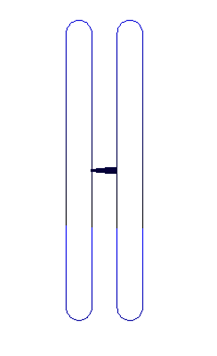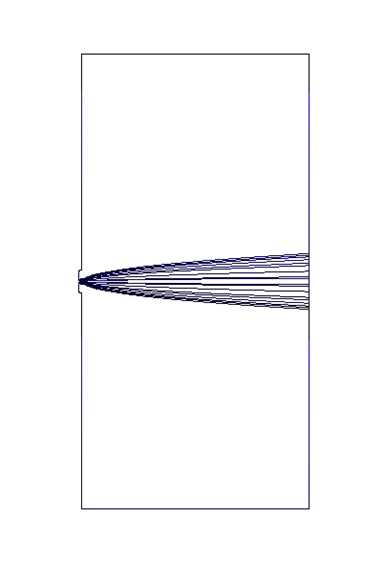Electrodes that are not 'seen' by the particles
Remember that in the BEM the sources of the fields are the charges that reside on the surfaces of the solid conducting electrodes. The charges on the surfaces nearest to the charged particles in a beam are the charges that have the greatest effect on forming the fields experienced by the beam. Other charges further away will have a smaller effect and some charges will have no effect at all because they are screened from the beam by other electrodes. We can say that such surface charges are not 'seen' by the beam, and since they have no effect on the electron optics of the system they should be removed because they only increase the computing time without adding any accuracy.
Here is an example. It is a field-emmision source. The gap between the plates is 10mm and the voltage difference is 50kV. The diameter of the system is 110mm. The source is a tip which is too small to be visible here.
Only the charges on the inner surfaces have any influence on the source and the electrons. Therefore the outer surfaces should be removed, because they have no effect on the electron optics and their presence only increases the time to set up the charges and trace the rays.

Here is the result of removing the unnecessay parts (with a different picture magnification):

The diameter has been reduced, the outer surfaces have been removed and outer 'bridge' electrodes which have a linear potential gradient have been added. The electron optics stays the same.
Here is another example, a two-tube electrostatic lens that has a short gap.

Again, the outer surfaces of the tubes do not effect the lens properties, and so can be removed:

We have chosen this example because it can be argued that when the gap is larger then the surfaces in the gap can have some effect. So here we have increased the gap, but have only used the parts of the surfaces that are near the gap:

This gives a reduction in computing time while retaining the accuracy of the simulation.
One exception is when extra 'unseen' electrodes are added behind a source in order to 'anchor' the potential of the source (which was not necessary in the example given above).
